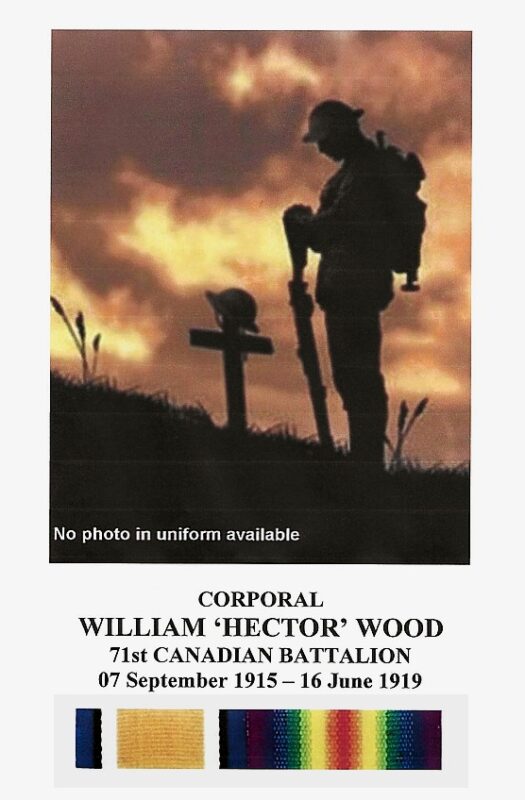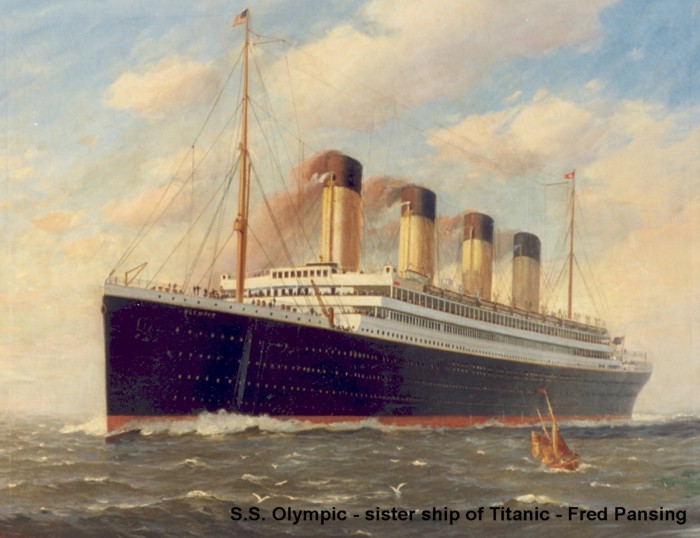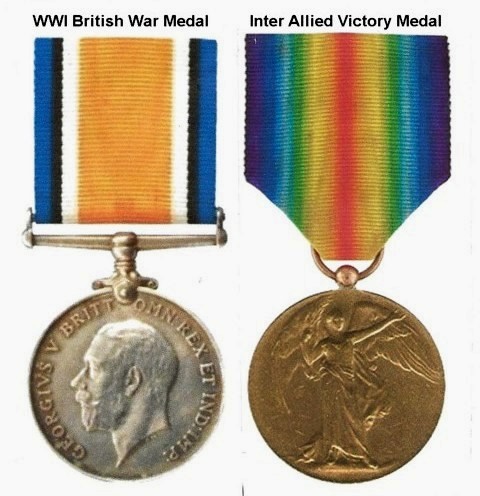
MILITARY HISTORY
CORPORAL WILLIAM “HECTOR” WOOD – No. -126112– Active Service (World War I)
On September 7th, 1915, William “Hector” Wood completed the Attestation Paper for the Canadian Active Service Force (CASF) at Tillsonburg, Ontario.
He was 22 years old when, as an unmarried man, he enlisted for the duration of the War. William was born in Lakefield, Ontario, and gave his birthdate as January 7th, 1893. He listed his present address as 79 Flora Street. St. Thomas, Ontario. William indicated that he had previous Military experience and he had served 1 year in the 34th regiment and 1 year in the 46th regiment in an Active Formation or Unit of The Canadian Army.
William indicated he had previously worked as a printer. He was described as standing 5 feet 8 ½ inches with a fair complexion and blue eyes, and dark brown hair. He was trained with the 71st Canadian Battalion in London and Halifax.
Corporal Wood sailed to England on April 1, 1916, on the SS Olympic and arrived in England on April 9th, 1916. He was promoted to Corporal on April 12th, 1916, and to A/Sergeant on October 3rd, 1916.

Corporal Wood was sent to France 11th of August 1916 and reverted to Corporal at his own request. He was transferred to the Canadian 4th Divisional TRN on 4th of September 1915.
4th Canadian Division (History)
The history of 4th Canadian Division
Formed in England in April 1916, the Division assembled at Bramshott and crossed to France in August 1916. As with other Canadian Divisions, lack of artillery was the constraint and the Division was initially joined by the former artillery of 3rd (Lahore) Division, recently attached to 3rd Canadian Division. Once overseas the Division fought in many of the major actions of the war, including:
1916
The Battle of Le Transloy*
The Battle of the Ancre Heights*
The Battle of the Ancre*
The battles marked * are phases of the Battles of the Somme 1916
1917
The Battle of Vimy**
Operations towards Lens**
The affairs south of Souchez River**
The capture of Avion**
The Battle of Hill 70**
The battles marked ** are phases of the Arras Offensive
The Second Battle of Passchendaele (a phase of the Third Battle of Ypres)
1918
The Canadian Divisions were not affected by the restructuring of the army to having three brigades per Division that took place in the British Divisions in February 1918. They were not involved in the defensive fighting against the German attack in spring 1918.
The Battle of Amiens and actions around Damery
The Battle of Drocourt-Queant (a phase of the Second Battles of Arras 1918)
The Battle of the Canal du Nord and the capture of Bourlon Wood^ (a phase of the Battles of the Hindenburg Line)
The Battle of Valenciennes and the capture of Mont Houy
The Battle of the Sambre and the passage of the Grand Honelle
The Division was not selected to advance into Germany and demobilisation commenced in late 1918. Most elements crossed to England in March 1919 and home soon after.
During the war Corporal Wood was hospitalized once on April 8th, 1917 in Field Hospital #51 in Etaples France. On September 7, 1917, he was awarded the Good Conduct badge and was discharged as fit to return to duty on 23rd of October 1917. Corporal Wood was returned to Canada on June 6th, 1919, and discharged from service on June 16th, 1919 in London Ontario.
Corporal Wood had served 2 years 9 month, 1 year in Canada/England, 1 year 9 months in France. He was eligible for the Volunteer Service medal, British War Medal (England and France).
An excerpt from an article in McLean’s magazine by Barbara Amiel, September 1996:
The military is the single calling in the world with job specifications that include a commitment to die for your nation. What could be more honorable?

PERSONAL HISTORY
WILLIAM “HECTOR” WOOD
William “Hector” Wood was born in Lakefield on January 7, 1893, the son of Arthur John Wood and Flora Rose Calder. Hector received his education in the Lakefield schools. Hector had four sisters and three brothers. In 1908, the family was living on Concession Street and Arthur was working at the Portland Cement Company as a burner and by 1911, the family had moved to Edward Street. Hector got work as a printer and with the closing of the Portland Cement Company during the war the large Wood family had to find work elsewhere and moved to St. Thomas, Ontario. In September 1915, Hector went to Tillsonburg and enlisted to serve his King and Country. After the war, Hector went home to London, Ontario. In 1921, Hector was living with his family and working as a printer. On March 18, 1925, Hector married Edith Mahalia Dimbleby in Stratford, Ontario. Edith was born in 1896, daughter of William Dimbleby and Naomi Martin. Her parents married June 1, 1892 in St. Thomas, Elgin County, ON. Hector was living in Stratford at the time of his marriage and was still in the printing business.
FAMILY HISTORY OF WILLIAM “HECTOR” WOOD
The maternal grandparents of William “Hector” Wood were Mr. and Mrs. James Calder.
The paternal grandparents of William “Hector” Wood were Elizabeth Chapman and William Wood.
The parents of William “Hector: Wood were Arthur John Wood born in Haliburton on October 16, 1869 and Flora Rose Calder born in Dummer Township on November 7, 1870. They were married in Warsaw on April 13, 1892. They made their home in Lakefield and had a family of eight children – Hector, Hazel, Leta Marguerite, Louisa May, Percy Arthur, George Clare, Kenneth Gordon and Mildred “Jean” Wood. Arthur worked for the Portland Cement Company as a burner until the cement factory closed during the war. The family moved to St. Thomas where Arthur found work as a labourer. Arthur passed away in 1943 and Flora died in 1942; both are buried in St. Thomas Cemetery, St. Thomas, Ontario.